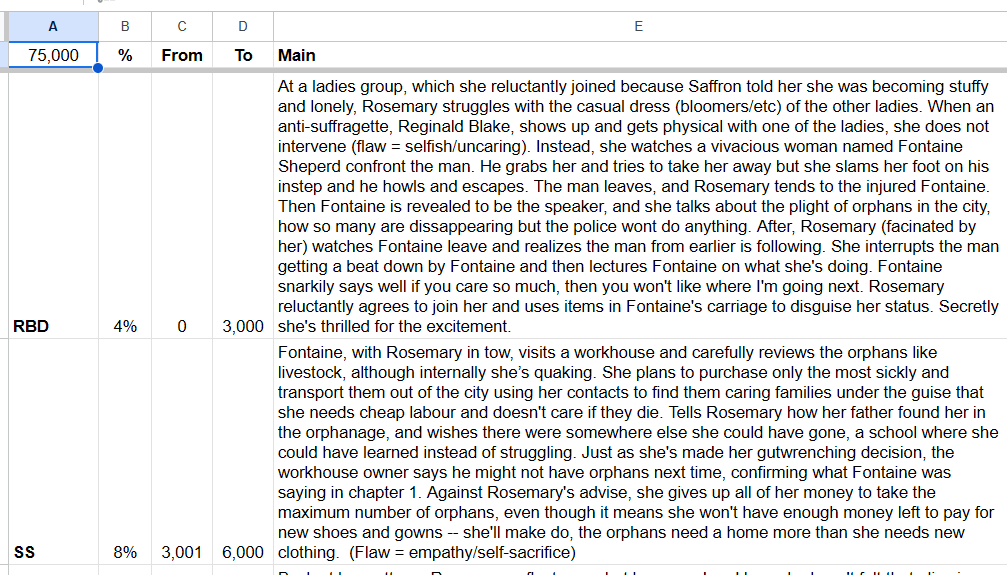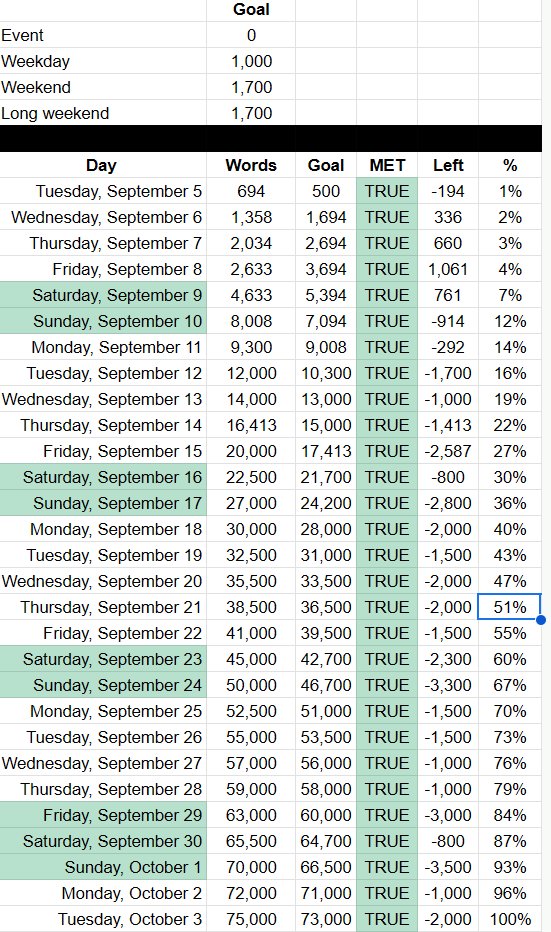Today I am describing the writing process that I used to write the 75k first draft of Benefactor to the Baroness in 28 days.
Disclaimer
This process works for me but it might not work for you, and that’s okay. I am neurodivergent, not disabled, have no dependents, and work from home. In other words, I have a long list of privileges that make it possible for me to devote a lot of time and mental energy to writing.
Synopsis
Before I start working on a project, I write a detailed synopsis that I share with my agent. My synopsis includes:
- Pitch (1 line): Two ladies fall in love while transporting orphans to Canada.
- Synopsis (500-1000 words): This includes major plot points and characters. Here’s a snippet:
- FONTAINE Shepherd’s plan to rescue a group of orphans from a brutal workhouse is jeopardized when the ship’s captain refuses to let her escort the orphans alone. Desperate, she asks and is rejected by every lady she knows…except one.
- Facing a lonely life after marrying off her nieces, ROSEMARY SUMMERSBY reluctantly joins a women’s suffrage group. There, she meets Fontaine Shepherd, a vivacious spinster who makes her feel things she has never felt before. One night, Fontaine stumbles into her cottage with an outrageous request.
- Character information: Character flaws and journeys. Here’s a summarized example for Rosemary Summersby (note that some of this changed by the time I finished the book):
- Lie: I don’t need anyone else to be happy.
- Goal: Accept that it is okay to need someone else.
- Motivation: Guilt for Basil leaving and hiding things from Saffron.
- Conflict: Fontaine’s relentless optimism, the ship’s captain.
- How she resolves her flaw: Rosemary writes to her nieces and admits that she imposed impossible standards on them growing up because they were forced upon her, but that doesn’t make it right (confront flaw). One of the orphans, Annie, comforts her and Rosemary begins to picture her life after Fontaine.
Writing this usually takes 3-4 days. When my agent approves my synopsis, I begin outlining.
Outlining
I use this 24 chapter outline and write a summary of each chapter. Usually I include sensory details for each chapter, but I skipped that step for BTTB.

This process usually takes 1-2 weeks.
Setup tracker
I use a spreadsheet to track the number of words I want to write each day. I usually set my daily word counts so that I am extremely confident I can make that goal. Usually, I double or triple that number each day. Why don’t I just set a bigger goal? No idea. For some reason, “completing” my daily goal first thing in the morning makes me motivated to complete “tomorrow’s” goal, too.

This process usually takes an hour.
Storyboarding
If I have extra time, I draw as many scenes as I can. This helps me visualize while writing. I skipped this step for BTTB, but I included an example from writing a different book.

This process usually takes 1-2 weeks.
Drafting
Now comes the hard part, turning off my editor brain. I am able to draft so quickly because I turn off the part of my brain that insists what I am writing isn’t good enough, or needs changes. To be clear, this DOES NOT work for everyone. There are many writers who prefer to edit as they go, which is completely valid. I am not one of them. The consequence of writing quickly, in my case, is messy drafting. It takes me 3-4 months to edit a first draft into something I am willing to share with beta readers.
To turn off my inner editor, I do the following:
- Change my font to match the background of the text editor so I can’t see the words as I write
- Dictate instead of using a keyboard (this took a LOT of practice)
- Turn on “Display word count while typing” in Google Docs
- Set a timer and force myself to write non-stop until the timer runs out (sprints)

I don’t stop writing, even if I have a stray thought.
Using these techniques, I write 2k words per day before I start work on weekdays, and 4-5k words on weekends.